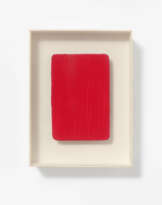ID 832057
Lot 26 | Yves Klein (1928-1962)
Estimate value
€ 1 000 000 – 1 500 000
Nu d’Iris Clert sortant de l’onde, (IKB 120)
signé, daté et inscrit 'Yves 57 Paris' (sur le revers); inscrit 'Nu d’Iris Clert Sortant de l’onde' (au revers)
pigment pur et résine synthétique sur toile montée sur panneau
36.5 x 73.5 cm.
Exécuté en 1957
signed, dated and inscribed 'Yves 57 Paris' (on the overlap); inscribed 'Nu d’Iris Clert Sortant de l’onde' (on the reverse)
dry pigment and synthetic resin on canvas mounted on panel
14 3/8 x 28 7/8 in.
Executed in 1957
Provenance
Galerie Iris Clert, Paris.
Wolfgang Hahn (acquis auprès de celle-ci en 1963).
Puis par descendance au propriétaire actuel.
Literature
P. Wember, Yves Klein, Cologne 1969, p. 74, no. IKB 120.
M. Compton, Pop art (movements of modern art), Feltham, 1970.
J-P. Ledeur,?Yves Klein, catalogue raisonné des éditions et des sculptures éditées, Knokke-le-Zoute 2000, no. IKB 120 (illustré en couleurs, p. 220).
Exhibited
Cologne, Wallraf - Richartz Museum, Sammlung Hahn, zeitgenössische Kunst, mai-juillet 1968 (illustré).
Special notice
Artist's Resale Right ("droit de Suite").
If the Artist's Resale Right Regulations 2006 apply to this lot, the buyer also agrees to pay us an amount equal to the resale royalty provided for in those Regulations, and we undertake to the buyer to pay such amount to the artist's collection agent.
Post lot text
Au cours des quelques années seulement qui constituent sa fulgurante trajectoire artistique, Yves Klein s’est érigé comme l’un des emblèmes de la radicalité artistique contemporaine. Si l’aventure du monochrome en peinture prend racine plus tôt au 20e siècle avec Malevitch, Klein va lui offrir une dimension nouvelle à partir du milieu des années 1950 grâce à un usage total et inédit de la couleur. Pour l’artiste, la couleur est en effet ce qui investit l’espace, tant réel que mental ; elle est ce par quoi il s’approprie cet espace, comme il investit le temps. « Par la couleur, je ressens le sentiment d’identification complète avec l’espace, je suis vraiment libre », dit-il ainsi (Y. Klein, L’aventure monochrome : l’épopée monochrome, 1960). Nu d’Iris Clert sortant de l’onde, (IKB 120) incarne cette démarche de façon emblématique : l’artiste travaille au rouleau, parcourant la surface de la toile appelée à devenir « un épiderme vivant à mesure que le peintre peint » (Y. Klein, note rédigée sur une feuille volante, in Yves Klein, le dépassement de la problématique de l’art et autres écrits, Paris, 2003, p. 415). Les bords et les angles de la toile s’arrondissent et s’estompent à mesure que le pigment déborde et envahit la surface ; et l’œil n’est bientôt plus en mesure d’identifier clairement les limites du tableau qui lui fait face.
De cette manière, la couleur pure se dilate et diffuse dans l’espace, donnant naissance à un objet qu’on ne parvient ni à rattacher tout à fait à une peinture, ni entièrement non plus à une sculpture. Cet effet de distorsion est renforcé par l’absence de cadre, souhaité par l’artiste : les œuvres s’offrent nues au regard et déploient leur vibration sans contrainte, comme flottant librement sur les murs et générant autour d’elle un espace immatériel. Le monochrome se révèle ainsi pour Yves Klein la méthode idéale pour amener les regardeurs à ce qu’il appelle les « zones d’immatérialités », résidant en dehors des domaines terrestres de l’espace et du temps. Et le bleu profond et magnétique de l’IKB est le vecteur permettant l’accès à cet infini. « Je cherche à mettre le spectateur devant le fait que la couleur est un individu, un personnage, une personnalité. Je sollicite une réceptivité chez l’observateur qui fait face à mes œuvres. Cela lui permet de considérer tout ce qui entoure effectivement le monochrome. De la sorte, il peut s’imprégner lui-même de la couleur et la couleur s’imprègne en lui. Ainsi, peut-être, est-il capable d’entrer dans un monde de couleur. » (Y. Klein cité par S. Stich in Yves Klein, catalogue de l’exposition à la Hayward Gallery, Londres, 1994).
Le titre de l’œuvre fait référence à celle qui fut l’une des plus ardentes défenseuse du travail de l’artiste, la galeriste Iris Clert. Née en Grèce dix ans jour pour jour avant Yves Klein, elle rencontre le peintre français en 1957, année de réalisation d’IKB 120, et participe à la promotion des Nouveaux Réalistes et des avant-gardes européennes entre sa première galerie rue des Beaux-Arts et les nouveaux espaces, plus vastes, qu’elle investit en 1962 rue du Faubourg Saint-Honoré. Personnalité fantasque et charismatique, à qui l’artiste grec Takis aurait très tôt dit qu’elle deviendrait bientôt « la Peggy Guggenheim de l'avenir », elle se voit ici inscrite par Yves Klein dans une tradition picturale pluriséculaire, décrite en nu sortant de l’onde, à la manière de la Naissance de Vénus de Botticelli (1484-1485), du Nu de la Vénus sortant de l’onde de Gustave Moreau (1863) et, de façon plus large, du Nu descendant un escalier No. 2 de Marcel Duchamp (1912), tableau décisif dans l’émergence de la modernité artistique du XXe siècle.
In the few years that made up his dazzling artistic career, Yves Klein established himself as one of the emblems of contemporary artistic radicalism. If the adventure of monochrome in painting took root earlier in the 20th century with Malevitch, Klein was to give it a new dimension from the mid-1950s thanks to a total and unprecedented use of colour. For the artist, colour is indeed what takes over space, both real and mental; it is how he appropriates space, just as he takes over time. “Through colour, I feel a sense of complete identification with space, I am truly free,” he explained (Y. Klein, The Monochrome Adventure: The Monochrome Epic, 1960). Iris Clert's Nude Emerging from the Wave, (IKB 120) embodies this approach in an emblematic way: the artist works with a roller, covering the surface of the canvas, which is called upon to become “a living epidermis as the painter paints” (Y. Klein, note written on a loose sheet of paper, in Yves Klein, le dépassement de la problématique de l'art et autres écrits, Paris, 2003, p. 415). The edges and corners of the canvas become rounded and blurred as the pigment overflows and invades the surface, and the eye is soon no longer able to clearly identify the limits of the painting in front of it.
In this way, pure colour expands and diffuses into space, giving birth to an object that is neither entirely paintable nor entirely sculptural. This effect of distortion is reinforced by the absence of a frame, desired by the artist: the works offer themselves naked to the eye and set forth their vibration without constraint, as if floating freely on the walls and generating an immaterial space. For Yves Klein, the monochrome thus proved to be the ideal method for leading viewers to what he called “zones of immateriality,” residing outside the terrestrial realms of space and time. And the deep, magnetic blue of the IKB is the vehicle for access to this infinity. “I seek to put the viewer in front of the fact that colour is an individual, a character, a personality. I solicit a receptivity in the observer who faces my works. This allows him to consider everything that actually surrounds the monochrome. In this way, he can impregnate himself with the colour and the colour impregnates itself in him. Thus, perhaps, he is able to enter a world of colour.” (Y. Klein quoted by S. Stich in Yves Klein, catalogue of the exhibition at the Hayward Gallery, London, 1994).
The title of the piece here refers to the gallery owner Iris Clert, who was one of the most ardent supporters of the artist's work. Born in Greece ten years to the day before Yves Klein, she met the French painter in 1957, the year IKB 120 was created, and participated in the promotion of the New Realists and the European avant-garde between her first gallery on Rue des Beaux-Arts and the new, larger spaces she moved into in 1962 on Rue du Faubourg Saint-Honoré. A whimsical and charismatic personality, to whom the Greek artist Takis is said to have predicted early on that she would soon become “the Peggy Guggenheim of the future,” she is here inscribed by Yves Klein in a centuries-old pictorial tradition, described as a nude emerging from the wave, in the manner of Botticelli's Birth of Venus (1484-1485), Gustave Moreau's Nude of Venus Emerging from the Wave (1863), and, more broadly, Nude Descending a Staircase No. 2 by Marcel Duchamp (1912), a decisive painting in the emergence of artistic modernity in the 20th century.
| Artist: | Yves Klein (1928 - 1962) |
|---|---|
| Art style: | Post War Art |
| Place of origin: | Western Europe, France, Europe |
| Auction house category: | Paintings |
| Artist: | Yves Klein (1928 - 1962) |
|---|---|
| Art style: | Post War Art |
| Place of origin: | Western Europe, France, Europe |
| Auction house category: | Paintings |
| Address of auction |
CHRISTIE'S 8 King Street, St. James's SW1Y 6QT London United Kingdom | |
|---|---|---|
| Preview |
| |
| Phone | +44 (0)20 7839 9060 | |
| Buyer Premium | see on Website | |
| Conditions of purchase | Conditions of purchase |











